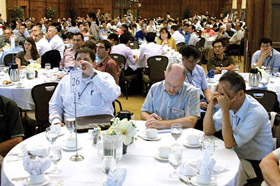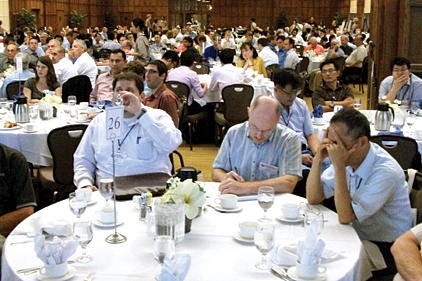
|
| A luncheon in the Student Union at Purdue University draws attendees of the conferences dealing with compressors, R/AC and high performance buildings. |
WEST LAFAYETTE, Ind. — When it comes to industrial and commercial refrigeration, high on the research radar screen are low global warming potential (GWP) alternative refrigerants for everything from small bottle coolers and freezers to entire supermarket systems.
This became evident during a two-hour session at the 14th International Refrigeration and Air Conditioning Conference at Purdue University this summer. It was one of 35 sessions, each of which had about a half dozen papers presented as part of the refrigeration and air conditioning track, which was held concurrently with sessions in the 21st International Compressor Engineering Conference and the 2nd International High Performance Buildings Conference.
In all, 372 papers were presented over four days. A record 580 persons attended the every other year conferences on the West Lafayette, Ind., campus of Purdue.
The five papers that were part of the industrial/commercial refrigeration session came from manufacturers, research organizations, and academia.
Beyond 134a
“Next-generation refrigerants with lower global warming potentials than traditional HFCs are being commercially introduced,” Shapiro said. For his research, “Drop-in performance tests were conducted in a commercial bottle cooler/freezer. Tests were conducted with R-134a as a baseline and several next-generation refrigerants and blends. The tests were conducted in accordance with ASHRAE Standard 72 at -5.6°C and 3.3°C bottle cooler temperature set points. Two ambient conditions were tested, 23.9°C/55 percent relative humidity and 26.7°C/55 percent relative humidity. In addition to the ASHRAE test conditions, full pull-down and half pull-down tests were conducted in accordance with a soft-drink bottler’s specifications. Performance parameters such as discharge air temperatures, product simulator temperatures, suction pressure, discharge pressure, compressor mass flow rate, and compressor input power were measured and compared.”
The refrigerants tested were identified as HFO-1234yf, XP-10, HFO-1234ze(E), and N-13. “With the exception of HFO1234ze(E), all the substitute refrigerants had similar performance as R-134a. HFO1234ze(E) had lower density at compressor suction conditions and therefore resulted in longer compressor run times and longer pull-down times. A larger displacement compressor would likely bring HFO1234ze(E) to roughly the same performance as the other refrigerants,” the report said.
Life Cycle
A recurring theme in a number of papers was for those involved in any phase-downs to consider the life cycle climate performance (LCCP) of equipment. On the most basic level this would involve whether or not a lower GWP refrigerant actually requires more energy to be as effective as the refrigerant it is replacing.
Using an LCCP design as a factor was one purpose of the paper from Oak Ridge National Laboratory in a presentation made by Brian Fricke. He noted, “In this study, an LCCP analysis was performed to determine the impact of drop-in and new refrigerant choices. HFC-407A was examined as a drop-in replacement for HFC-404A in the traditional multiplex DX system while the R-744 transcritical booster system was investigated as replacement for the HFC multiplex DX system.
“R-407A showed a 37 percent emission reduction compared to R-404A. R-407A is an attractive drop-in replacement for R-404A and requires minimum system modifications.
“The R-744 trans-critical booster system exhibited a 77 percent emissions reduction compared to R-404A. This level of emissions savings cannot be achieved by simply replacing the refrigerant. A total system change is required. Furthermore, the emissions savings comes at the cost of higher energy consumption, which is critical for the operation of supermarket refrigeration systems. While not considered in this study, secondary loop systems with lower GWP refrigerants may also warrant further investigation as a means to achieve significant emissions reductions.”
Back To Brayton?
The Brayton Cycle is a thermodynamic cycle that describes the workings of the gas turbine engine, and dates back to the 1800s. It is considered the basis of the air-breathing jet engine.
Has its time come to be in HVACR, especially transport? That was the basis of a paper from Brazilian researcher Carlos Nobrega titled “Modeling and Simulation of a Desiccant Assisted Brayton Refrigeration Cycle.”
He wrote, “The phaseout of CFCs has shed a new light over natural refrigerants, which have null global warming potential. Air would be a natural choice, and although the Brayton cycle usually exhibits a lower coefficient of performance when compared to vapor-compression systems of same capacity, it has been considered in applications other than aircraft cooling. These include gas separation, food processing and preservation, refrigerated containers, and train air conditioning. Price perspectives in the oil market also make the Brayton cycle an alternative to be considered as an option for automotive air conditioning.”
Another Aspect
Another aspect in terms of transport refrigeration suggested the many directions research is going. In the case of a paper from Donal Finn who did a study with three other colleagues involving educators and manufacturers in Ireland and Spain, the approach was to look at the secondary loop approach in transport refrigeration.
He noted, “The use of secondary working fluids, in conjunction with secondary loop refrigeration (IDX) system design, is gaining increased interest for certain applications, as an alternative approach to direct expansion (DX) systems. This is particularly so where long refrigerant pipe runs and refrigerant charges are required.
“As with DX systems, defrosting of the chillers is a key operational issue in IDX system design.” He described, “A mathematical model of the defrost process in a finned-tube air chiller, utilized as a heat exchanger in a secondary loop multitemperature transport refrigeration system, where an antifreeze mixture is deployed as a secondary working fluid. Two defrost modes are modeled; an electric defrost mode which effects defrost by localized resistance heating of the secondary working fluid and a hot gas primary circuit defrost, that indirectly heats the secondary working fluid by means of a primary to secondary heat exchanger.”
Overview
Sometimes amidst all the highly technical papers there come those that are reflective on why all the research is being done. Such was the case of a paper from Rafiqul Islam of Austral Refrigeration of Australia. While his paper did look at a wide range of supermarket equipment and technologies, it was his conclusion that he asked listeners to focus on.
“Supermarkets are an integral part of modern living, but they also became a resource and environmental burden to the current and future human existence. This article was mainly focused on elaborating on core values of sustainability in supermarkets. It is important that the integrated approach must be taken into consideration, then a sensitivity analysis is to be performed to optimize sustainability goals. Technological, socio-cultural, and behavioral facets are connected to environmental and energy resource impact. Though it is a good practice to offer sustainability solutions on individual components of the whole body of supermarkets, the integrated approach can ensure that one sustainability measure does not oppose another sustainability measure.
“While we focus on climate change, we must not compromise reducing energy resource depletion, usefulness, and safety to humans due to application of any alternative practices. Even if it meant that we must change our way of life, then so be it, so we secure a longer-term equitable future for coming generations.”
Publication date: 9/3/2012



Report Abusive Comment